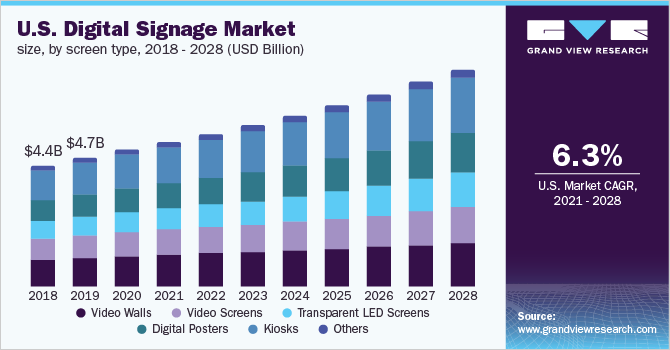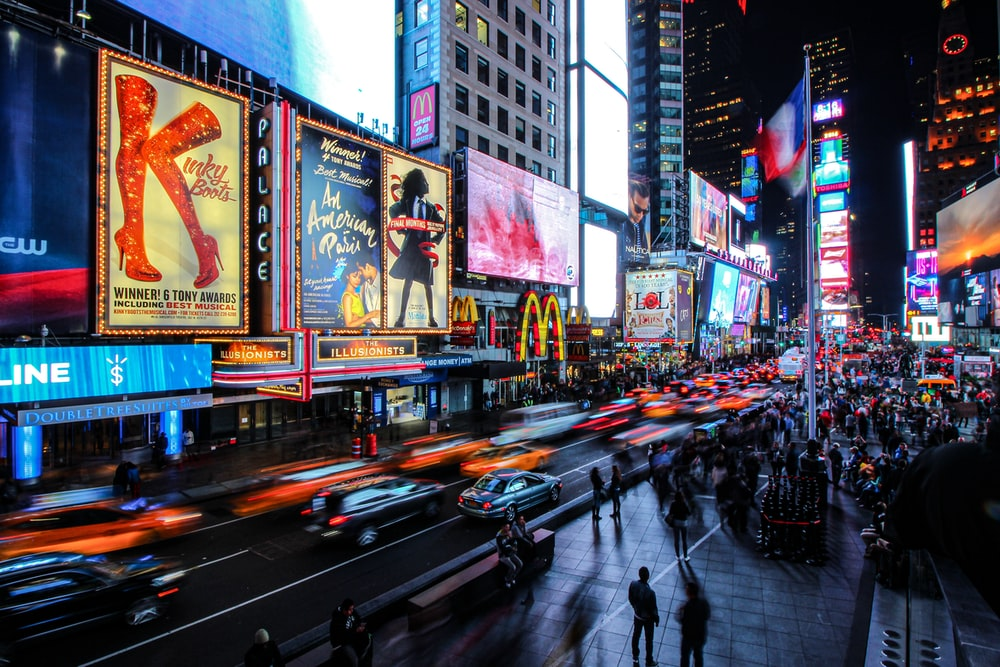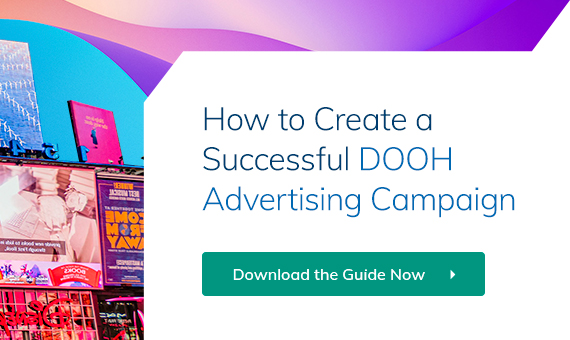Digital out-of-home advertising (DOOH) uses digital media to deliver advertising and marketing messages through a variety of out-of-home channels.
Whether it’s via LCD screens in public places, kiosks on public transportation, or screens embedded in the city landscape itself, DOOH provides marketers with an opportunity to reach consumers where they are most likely to be receptive to messages – when they’re outside their homes.
DOOH has grown in leaps and bounds since the first digital billboards emerged in 2005. Since then, the digital signage industry has been expanding rapidly worldwide and was valued at USD 21.49 billion in 2020.
According to Grand View Research, the US digital signage market is projected to grow at a compound annual growth rate (CAGR) of 7.5% between 2021 to 2028.

(Image source: grandviewresearch.com)
The rapid expansion of digital advertising is due to several distinct advantages over traditional printed OOH.
One of the most important is its ability to tap into digital data about consumers’ behavior and preferences.
Digital Out of Home Advertising Advantages
Below is an examination of the advantages of DOOH over other forms of advertising.
DOOH Makes Use of Digital Data About Consumers
There are several advantages digital media has over traditional forms of advertising and marketing, but one in particular is the availability of data.
Digital data allows businesses to make far more accurate predictions about consumers’ preferences than was previously possible. When combined with programmatic capabilities, advertisers can use this digital information to tailor advertising to consumers – and that’s a huge advantage over traditional OOH ads.
These digital data sources include:
- Location data: digital data can be used to provide advertisers with up-to-the-minute information about an individual consumer’s whereabouts. This is of great value for advertisers, who now have the opportunity to tailor advertising based on an individual consumer’s current location, the weather in the area, traffic information and much more.
- Demographic data: digital data is also extremely valuable when it comes to demographic targeting, allowing advertisers to tailor advertising and serve ads based on where their target audience is most likely to be. Additionally, some interactive DOOH displays come with built-in facial recognition cameras, allowing advertisers to serve customized messages based on a viewer’s gender or estimated age.
- Behavioral data: digital data also enables digital advertisers to show more relevant ads based on consumers’ behavioral and movement patterns.
- Psychographic data: digital data also allows digital advertisers to make better predictions about their consumer’s attitudes and show more relevant ads.
Cost-Effective
When programmatic DOOH (pDOOH) platforms are used to display ads based on location, weather and other data, DOOH advertising is far more cost-effective than traditional out-of-home ads. Digital signage can be targeted quickly, easily and in real-time to display the right message to the right consumer in the right place at the right time.
This also means that DOOH has a better Return on Investment (ROI) than other forms of advertising.
Digital Out-of-Home Advertising has Wide Reach
DOOH advertising is also highly effective because digital media can reach digital consumers at a scale of magnitude that has never been previously possible. In addition, DOOH networks are continuously expanding across formats and locations – creating a network effect that is far greater than other forms of digital advertising.
According to studies, DOOH ads are twice as likely to be seen and two and half times more impactful than standard OOH ads when combined with social media campaigns. This means that digital out of home advertising can reach consumers with greater frequency than other digital formats – making it a highly effective form of advertising.
Better Metrics
Finally, pDOOH advertising provides actionable analytics and campaign data to advertisers. Offering advanced behavioral analysis tools, buyers can access and react to this information in real time at an increasingly granular level and optimize their campaign immediately.
This is practically impossible when you’re buying traditional ad space.
Disadvantages of Digital Out Of Home Advertising
DOOH is a highly effective form of digital advertising, but there are a few minor disadvantages of out-of-home advertising. One example is the relatively high costs that marketers incur to use billboards and other digital signage, so businesses need to be careful about how many digital ads they buy and where they are placed.
However, this is easily solved by investing in a programmatic DOOH solution that we explain below.
Programmatic Digital Out of Home Advertising (pDOOH)
Programmatic digital out of home advertising automates the process of negotiating, buying and placing DOOH ads.
pDOOH advertising also makes use of artificial intelligence to select the right digital screens and locations.
For example, The Neuron’s pDOOH solution allows businesses to access location-based intelligence through various data feeds such as weather, news, timetables, flight information, social media, traffic and retail trends.
These data feeds are all GDPR compliant.
Advertisers can easily leverage this information for granular targeting to make the most out of their ad budget and maximize ROI.
What’s more, advertisers can cut the time they need to plan and launch a campaign from weeks to a matter of minutes. This is because The Neuron’s pDOOH platform provides advertisers with access to a massive global inventory of DOOH assets, automated ad bidding, a booking system and an easy-to-use dashboard to execute campaign optimization on the fly.
Connect with The Neuron today for a live demo on how to reap the advantages of programmatic digital out of home advertising.


